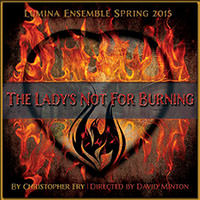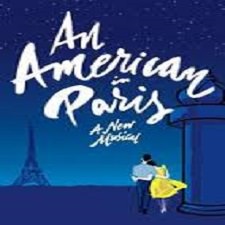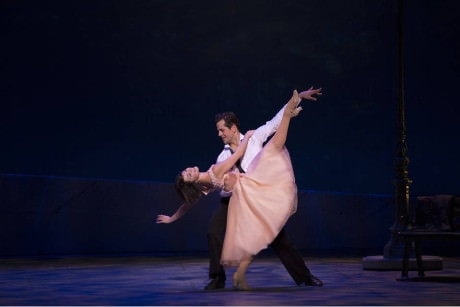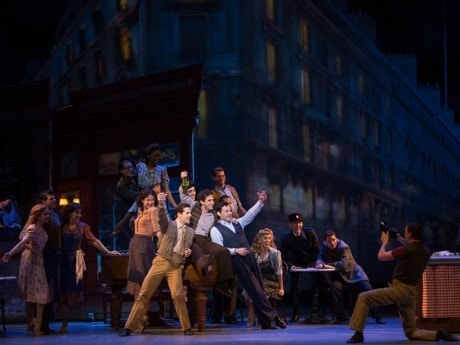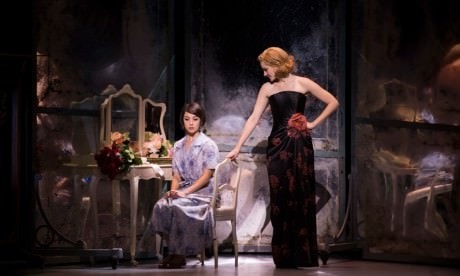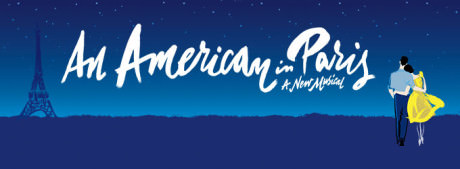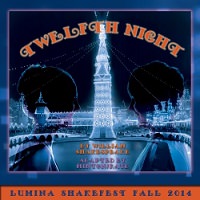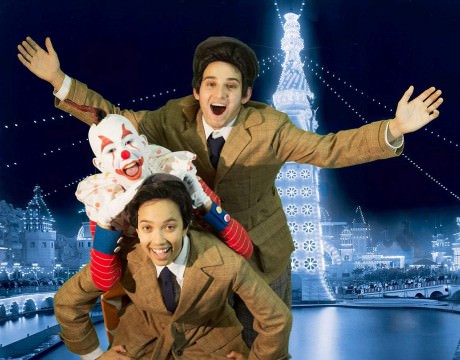It was an active year, heavily marked by new and revisited musicals. The attendance and box office numbers were good, both on and off Broadway. I, as the only writer covering New York theater for DCMTA, could not see everything, but from the 35 plays and musicals I did attend, I submit the ten that I found most distinctive. I list them in no particular order, but all of them rewarded me on any number of levels.
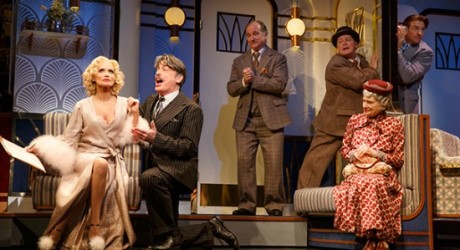
(1) In mid-March, when I joined DCMetroTheaterArts, I reported that On The Twentieth Century at the Roundabout was in the capable hands of director Scott Ellis and Choreographer Warren Carlyle who gave it a sleek and lively new look. It’s always interesting to see good material interpreted by original artists who, as performers, start from scratch and build their own characters. Certainly Kristin Chenowith, Andy Karl, Mary Louise Wilson, Michael McGrath and Mark Linn-Baker gave us musical comedy fun all night long. Leading man Peter Gallagher is just a bit too sane to have given theatre genius Oscar Jaffe the barely hidden madness that made him move, but he looked the part and sang well.
Comden and Green, late in their careers as book writers and lyricists, here proved they never lost their ability to take perfectly ordinary people and turn them into highly original lunatics and lovers. And Cy Coleman sprinkled his musical notes all along the way. Together all of these gifted artists, totally committed, came up with a merry musical.
______
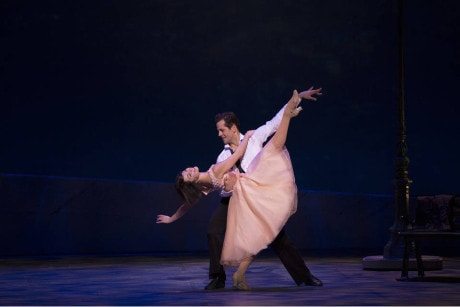
(2) Barely a month later, An American In Paris opened on Broadway. It’s a prime example of creative people tackling a beautifully wrought film, and delivering a fresh version of the source material that shines like any great original musical must. Introducing us to Robert Fairchild, on leave from the New York Ballet, was a major plus because as leading man he was notable as singer, dancer and actor. He’d have been snapped up by MGM in an instant had this been played out first onstage, before the film was made, just as Gene Kelly was spotted in Pal Joey on Broadway, and whisked west for a major career on screen.
The delightful George and Ira Gershwin score, (which used highlights from the film, but was augmented by many numbers to serve the new book), that new book by Craig Lucas and the direction and choreography of Christopher Wheeldon all melded to transform the movie into something we’d not seen before, and now we could relish it live on stage.
______
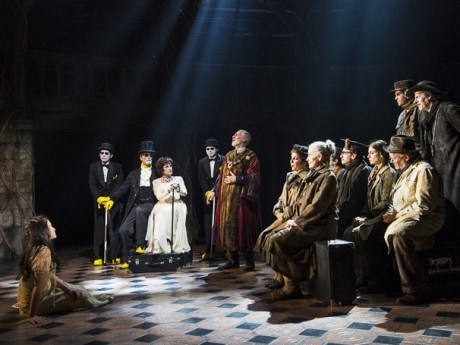
(3) The Visit continued the rush of openings racing to happen in time for consideration by the Tony Award committee. It is the last of the many collaborations by John Kander and the late Fred Ebb, the last of the four mostly completed works that Ebb left behind. The other three were finished by Kander and in some cases by other collaborators who contributed finishing touches.
The last of the four was The Visit, a dark musical about revenge that is based on a Dürenmatt play of the same name. It had served the Lunts as a drama, and was in fact their swan song on Broadway, where it was highly regarded. An unlikely source for a musical because it told a very dark story, dealing with revenge for a hurt imposed years earlier. In it, Claire Zachanassian, the world’s richest woman, returns to her desperately poor home town, from which she’d been banished many years earlier when her lover had abandoned her to marry another woman.
Terence McNally, a frequent Kander and Ebb collaborator, adapted the play and wrote an engrossing story of this wealthy woman, her ex-lover and some of the key people of the town. It deals with greed, perfidy, betrayal but remains a love story gone wrong, and there is romance in it when it flashes back.
The score is one of the team’s loveliest, and songs like “Only Love,” “You,” “Yellow Shoes,” and others will live on. I found the show memorable, more so because it offered Chita Rivera the role of a lifetime, and she triumphed in it. I saw it in all three regional productions that preceded Broadway and it was richly rewarding to watch it grow until it positively glowed. It was not popular and only managed a three-month run, but it’s a major work in my opinion, and belongs on any “Best 10 list.”
______
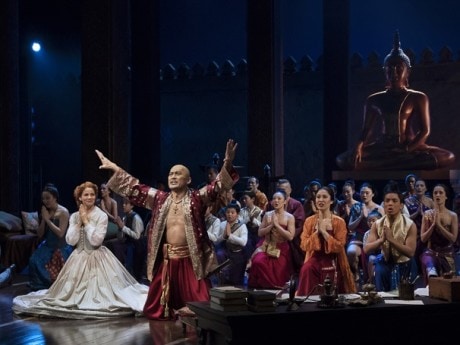
(4) Days after my visit to The Visit I was at Lincoln Center’s large Beaumont Theatre to catch Bartlett Sher’s production of the Rodgers and Hammerstein classic The King and I. Kelli O’Hara has been lighting up Broadway season after season in some ten musicals since 1997, and her work in South Pacific, The Light In The Piazza, and The Bridges of Madison County prepared her for her major star turn as Anna Leonowens which is still playing at Lincoln Center.
Her new “King” replacement, Hoon Lee, is younger than the original King and is reported to be bringing a more sensual quality to the relationship he has with “Mrs. Anna.” I urge you to see this production, for it is unlikely to be bettered — ever.
______
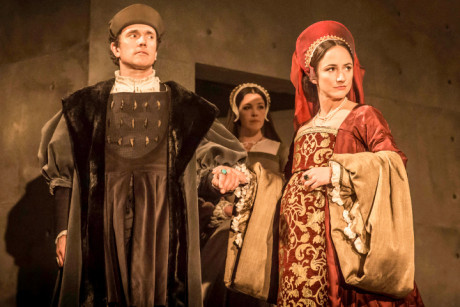
(5) The year wasn’t devoted exclusively to musicals. They certainly led the way to record breaking grosses, but in addition to holdover hits like The Curious Incident of the Dog in the Night-Time, the British import Wolf Hall arrived in the April rush. This monumental work was really one long play, running some six hours, but to make it user friendly, it was played out with the one title, on two evenings. One could see the two at matinée and evening on the same day. The first play deals with Henry VIII and his life on the throne through his marriage to Anne Boleyn, the second one opens as he is on the verge of marrying Jane Seymour. It dealt with the banishment and ultimate death of Cardinal Woolsey whose power over the English throne was potent when Henry began his reign.
The evenings were filled with rich and informative performances by Ben Miles and this excellent company of British actors. A vast and entertaining history lesson, and a worthy addition to the season it graced.
______
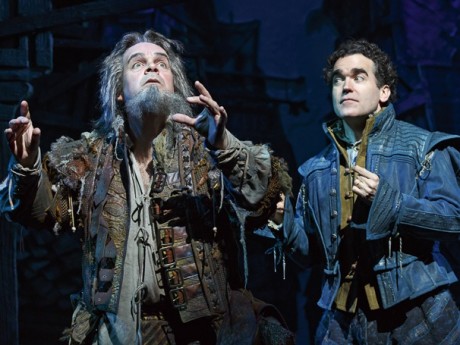
(6) April continued to shower us with well conceived and executed products. A refreshing original musical (Something Rotten!) with nothing on its mind but amusement, took up residence in the St. James Theatre, once home to Oklahoma!, The King and I, The Producers, Hello, Dolly! and other crowd-pleasers, where it remains happily pleasing large audiences as it rounds out its first year. This lighthearted romp involving show folk trying to make a buck in London in 1599 offers a cast of farceurs who are tops.
I enjoyed Tony Award winner Christian Borle (so great in Peter and the Starcatcher) and Brian D’Arcy-James (who has played with great range all sorts of plays and musicals. This is his first outing in farce since he was a youngster playing the bellboy in Lend Me a Tenor in Ohio. (I know he can play farce because I was in that production and he was hilarious). It features such great character actors as Brad Oscar, Brooks Ashmanskas, John Cariani, Peter Bartlett and the lovely Kate Reinders, and Heidi Blickenstaff. Check your troubles in the lobby, and c’mon, get happy.
______
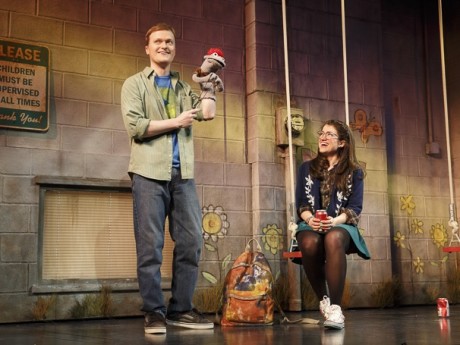
(7) April continued to bring May flowers along with 3 and 4 openings a week! I was so busy I didn’t get to see one of those, an original play by Robert Askins called Hand to God. I finally caught it in early June, but its originality and brave use of controversy are still imbedded in my head. As I wrote then: “Askins takes us on a journey into little known territory and with the aid of a first rate cast, he helps us to understand and relish the little band of broken very human beings.” The play deals with the preparation of a Christian puppet show, and the Pastor is demanding that it must be ready within a week.
One of the participants is Jason, a soft spoken lad who has made himself a hand puppet he calls “Tyrone.” Suffice it to say that Tyrone has a mind of his own, and as an extension of Jason’s arm, he will spend most of the evening shocking us as he becomes adversary to the world, particularly when he spots anyone being evasive in answering a tough question. He is the dark side of Jason, and he’s as scary as the demon inside the girl in The Exorcist. Shocking and provocative, beautifully executed theatre that’s been thrilling audience for most of the year. It will play its last performance on Broadway this Sunday, January 3rd, but I’m certain it will pop up again wherever a theatre company can find an actor of the caliber of Steven Boyer to play both roles, often in the same sentence.
______
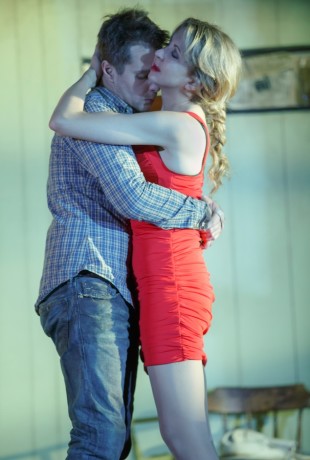
(8) Fool For Love deserved a return run (it originally opened in 1983 at Circle Rep) if for no other reason than to give the iridescent Nina Arianda a role she can fully inhabit, not to mention one that can do the same for Sam Rockwell. Set in a motel in the Mojave Desert, it’s the re-uniting of a pair of untidy lovers and they will interest you whether or not you’ve ever met anyone like them. Rough and tumble, that’s them – and the tumbling gets fairly rough between clinches. Ed Harris and Kathy Baker had a field day (and big career boosts) from the original production, as have many other actors in the ensuing years.
It’s an early Shepard play; Eddie and May, the two principals characters, will be around indefinitely for their connection is visceral and will not date. There is tenderness and violence within them, with many shades in between, This production lent drama to the year, and deserves credit for that.
______
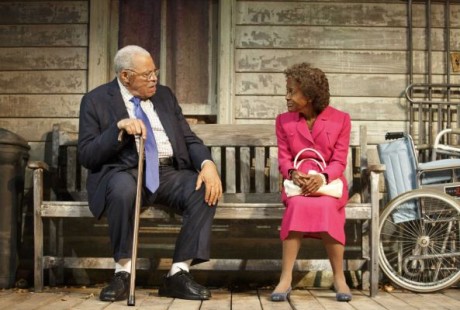
(9) To move from Sam Shepard’s Fool For Love to Donald L. Coburn’s The Gin Game is almost like mentioning Charley’s Aunt and Medea in the same breath, in that one is a gut wrenching tug of war between two turbulent characters and the other is a love letter to two aging individuals who have built armor against hurt. Both plays are rich in detail, and are immensely satisfying. Of course plays are meant to be acted, and when that’s well done, an audience can be transformed. James Earl Jones has great range, and in this play he sensibly keeps under control his resonant baritone voice, so useful to him in the past in roles that require thunder (The Emperor Jones is one, The Great White Hope is another). But in this he is just an old guy who is lonely, (Weller Martin) living in a retirement home, who tries to break through the shell constructed by a fellow retiree (Fonsia Dorsey). It’s just the two of them, a series of gin games, and the unfolding of two deep and meaningful relationships, that make up this Pulitzer Prize-winning play.
This production has the good fortune to have Cicely Tyson playing Fonsia. In it she fulfills the promise she showed in her lovely performance in The Trip to Bountiful for which she won the Tony Award. Now over 90, she is in full command of her talent, and her Fonsia is another character she has created from the text, from her imagination, and from her great gift as a creative artist. She never seems to be acting; she is just being. Every moment is real, and as Mr. Coburn has affection and understanding for his characters, some of the effects are chilling, others are terribly funny, many more are just plain touching. An old play, somewhat forgotten, given vibrant new life by two actors in their ancient age, blessed with the ability to deliver.
______
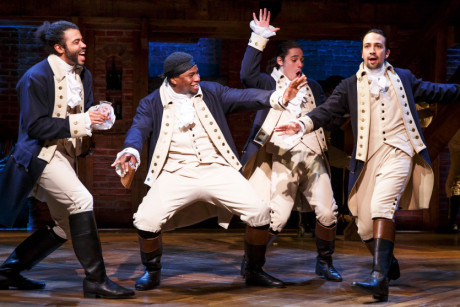
(10) The tenth selection I make is virtually mandatory. I refer of course to Hamilton, the incredible achievement of Lin-Manuel Miranda, who wrote the book, music and lyrics and manages to play the central role as well. Noel Coward used to do all that, but that was in the age when theatre folk were revered, when cocktails and cocktail hours were evident in all the smart places, when cigarette smoking was a very sophisticated thing to do.
There is no one like Miranda today, and the theatre is blessed to have him. In the so-called Golden Age we had a dozen or more teams of writers prolifically producing theatre, season after season, including Irving Berlin, Rodgers with Hart and Hammerstein, Lerner and Loewe, Cole Porter, Frank Loesser, Jule Styne, Schwartz and Dietz, Harold Rome, Noel Coward, and more, was followed by the next generation, equally gifted and interested in keeping musical theatre alive and thriving. In that group — Kander and Ebb, Stephen Sondheim, Jerry Herman, Bock and Harnick, Adams and Strouse, Jones and Schmidt and a dozen others. But the generation after that — brought us Stephen Schwartz, William Finn, Craig Carnelia, and Jason Robert Brown.
Now, it’s the post-AIDS generation and Lin-Manuel Miranda is the titan who emerges from it to give us all hope. His Hamilton is audacious, original, and satisfying. It’s different, it casts casting correctness aside with some interesting results, and its rap score will not work for everyone, but it is original and pungent. He is our hope for the future, and of course his work must be on any list of bests that is worth its salt. So here is Hamilton, the biggest hit since Oklahoma!
_____
I have two latecomers for you, as alternates. One, School of Rock-The Musical, surprised me for I really can’t take rock in the theatre (it’s too loud for me, it’s not always about melody and it takes all nuance out of lyrics).
But this simple tale of under achieving kids finding something to give them confidence, Sir Andrew Lloyd-Webber (the show’s composer) has written some stirring anthems and has found Alex Brightman, who is tireless in the leading role, and very funny and appealing. And for once stage kids are appealing and genuinely talented.
______

Another juke box musical is called On Your Feet!) and is the story of composer/performer Gloria Estefan and her husband. It’s a jolly night out with a superb cast and some wildly exuberant staging by Jerry Mitchell which has you doing the Conga on your way out.
https://www.youtube.com/watch?v=mkZ1_RL1J3U
Both shows are happy editions to the scene on Broadway as 2015 calls it a day.
LINKS:
Read Richard Seff’s New York reviews.
DCMetroTheaterArts’ Best of 2015 #1: Special Awards.
DCMetroTheaterArts’ Best of 2015 #2: Best Musicals in Professional Theatres.
DCMetroTheaterArts’ Best of 2015 #3: Best Musicals in Community Theatres.
DCMetroTheaterArts’ Best of 2015 #4: Best Plays in Professional Theaters.
DCMetroTheaterArts’ Best of 2015 #5: Best Plays in Community Theatres.
DCMetroTheaterArts’ Best of 2015 #6: Best Children’s/Family Productions.
DCMetroTheaterArts’ Best of 2015 #7: Best Performances in a Play in Community Theatres.
DCMetroTheaterArts’ Best of 2015 #8: Best Performances in a Play in Professional Theatres
DCMetroTheaterArts’ Best of 2015 #9: Best Performances in a Musical in Community Theatres.
DCMetroTheaterArts: Best of 2015 #10: Best Performances in a Musical in Professional Theatres and Special Awards.
DCMetroTheaterArts’ Best of 2015 #11: New York’s Ten Best of 2015 by Richard Seff.
DCMetroTheaterArts’ Best of 2015 #12: ‘Memorable Dance in Baltimore and Beyond’ by Carolyn Kelemen.
DCMetroTheaterArts’ Best of 2015 #13 in Theater in The Philadelphia Area.
DCMetroTheaterArts’ Best of 2015 #14: Dance Performances.
DCMetroTheaterArts’ Best of 2015 Honors Begins Tomorrow-A Look Back at the 2014 Honorees.
______
DCMetroTheaterArts writers were permitted to honor productions that they saw and we did not review.

